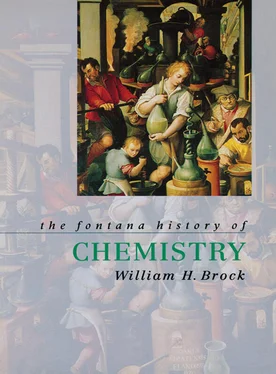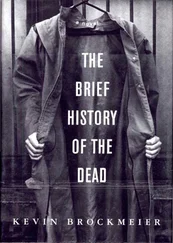Like Darwin’s Origin of Species , Lavoisier’s Traité was a hastily written abstract or prolegomena to a much larger work he intended to write that would have included a discussion of affinity, and animal and vegetable chemistry. Like Darwin’s book, it was all the more readable and influential for being short and introductory. If more information was required, Fourcroy’s encyclopedic text and its many English and German imitations soon provided reference and instruction. But this was not the end of the chemical revolution. To complete it, Lavoisier’s elements had to be reunited with the older corpuscular traditions of Boyle and Newton. This was to be the contribution of John Dalton.
4 A New System of Chemical Philosophy
Atoms are round bits of wood invented by Mr Dalton.
(H. E. ROSCOE, 1887)
Before Dalton came on the scene, chemistry can hardly be described as an exact science. A wealth of empirical facts had been established and many theories had been erected that bound them together, not the least impressive of which were Lavoisier’s new dualistic views of chemical composition and his explanations of combustion and acidity. Most of eighteenth-century chemical activity had been qualitative. Despite the Newtonian dream of quantifying the forces of attraction between chemical substances and the compilation of elaborate tables of chemical affinity, no powerful quantitative generalizations had emerged. Although these empirically derived affinity relations often allowed the course of a particular chemical reaction to be predicted, it was not possible to say, or to calculate, how much of each ingredient was needed to perform a reaction successfully and most economically. Dalton’s chemical atomic theory, and the laws of chemical combination that were explained by it, were to make such calculations and estimates possible – to the benefit of efficient analysis, synthesis and chemical manufacture.
As a consequence of the power of the corpuscular philosophy, by the end of the seventeenth century it had become a regulative principle, or self-evident truth, that all matter was ultimately composed of microscopic ‘solid, hard, impenetrable, moveable’ particles. As we saw in the second chapter, however, such ultimate descriptions of Nature were of little use to practical chemists, who preferred to adopt a number of empirically derived elementary substances as the basic ‘stuffs’ of chemical investigation. Lavoisier’s famous definition of the element in 1789 made it clear that speculations concerning the ultimate particles or atoms of matter were a waste of time; chemistry was to be based on experimental knowledge 1 :
All that can be said upon the number and nature of elements [i.e. in an Aristotelian or Paracelsian sense] is, in my opinion, confined to discussions entirely of a metaphysical nature. It is an unsolvable problem capable of an infinity of solutions none of which probably accord with Nature. I shall be content, therefore, in saying that if by the term elements we mean to express those simple and indivisible atoms of which matter is composed, it seems extremely probable we know nothing at all about them; however, if instead we apply the term elements or principles of bodies , to express our idea of the last point which analysis is capable of reaching, we must admit as elements, all the substances into which we are capable, by any means, to reduce bodies during decomposition. Not that we can be certain that these substances we consider as simple may not be compounded of two, or even a greater number of principles; but, since these principles cannot be separated, or rather since we have not hitherto discovered the means of separating them, they act with regard to us as simple substances, and we ought never to suppose them compounded until experiment and observation has proved them to be so.
For the same reason, although Dalton believed in physical atoms, most of his interpreters were content with a theory of chemical atoms – the ‘minima’ of the experimentally defined elements. Whether these chemical atoms were themselves composed from homogeneous or heterogeneous physical atoms was to go beyond the evidence of pure stoichiometry.
Stoichiometry was a subject invented by the German chemist Jeremias Richter (1762–1807), who had studied mathematics with the great philosopher, Immanuel Kant, at the University of Königsberg, and for whom he wrote a doctoral thesis on the use of mathematics in chemistry. This was, in practice, nothing grander than an account of the determination of specific gravities, from which Richter calculated the supposed weights of phlogiston in substances. Just as Kepler had searched for mathematical relations and harmony in astronomical data gathered by Tycho Brahe, so Richter spent his spare time as a chemical analyst in the Berlin porcelain works searching for arithmetical relations in chemistry. As Partington noted sardonically, Richter spent his entire life finding ‘regularities among the combining proportions where nature had not provided any’.
The exception was his discovery in 1792, while investigating double decompositions, that, because neutral products were formed, the reactants must ‘have amongst themselves a certain fixed ratio of mass’.
If, e.g., the components of two neutral compounds are A – a, a and B – b, b , then the mass ratios of the new neutral compounds produced by double decomposition are unchangeably A – a:b and B – b:a.
This law of neutrality was a special case of what came to be known as the law of reciprocal proportions. Richter referred to the study of these ratios as ‘stoichiometry’ and went on to examine how a fixed weight of an acid was neutralized by different weights of various bases. This investigation led him to claim, erroneously, that combining proportions formed arithmetical and geometrical series. It was Ernst Fischer, a Berlin physicist, who, when translating Berthollet’s Recherches sur la lois de l’affinité into German in 1802, pointed out that Richter’s results could be tabulated to show equivalent weights of a series of acids and bases. If 1000 parts of sulphuric acid was taken as a standard and the base equivalents needed for neutralization arranged in one column, and the amounts of other acids needed to neutralize these bases in another, then an analyst could gather at a glance how much of a particular base would neutralize a particular acid:
Thus, 672 equivalents of ammonia neutralized 427 of fluoric, 577 of carbonic and 712 of muriatic acids. Analysts now had a definite method of controlling the accuracy of their work and of calculating beforehand the composition of salts under investigation.
Dalton’s atomic theory was to provide a rational explanation for these regularities. There has been some debate as to whether Dalton was directly influenced by Richter. He certainly knew of Richter’s investigations, but probably not until after he had derived his own explanation from other sources.
What was ‘new’ in John Dalton’s A New System of Chemical Philosophy ? The obvious reply seems to be the introduction of chemical atomism – the idea that each of Lavoisier’s undecompounded bodies was composed from a myriad of homogeneous atoms, each element’s atom differing slightly in mass. The surprising thing, however, is that only one chapter of barely five pages in the 916-page treatise was devoted to the epoch-making theme. These five pages, together with four explanatory plates, appeared at the end of the first part of the New System , which was published in Manchester in 1808 and dedicated to the professors and students of the Universities of Edinburgh and Glasgow, who had heard Dalton lecture on ‘Heat and the Chemical Elements’ in 1807, and to the members of Manchester’s Literary and Philosophical Society, who had ‘uniformly promoted’ Dalton’s researches. A second, continuously paginated, part of the New System , dedicated to Humphry Davy and William Henry, was published in 1810. Astonishingly, the third part, labelled as a second volume, did not appear until 1827. Even then the design was incomplete and a promised final part concerned with ‘complex compounds’ was never published.
Читать дальше












